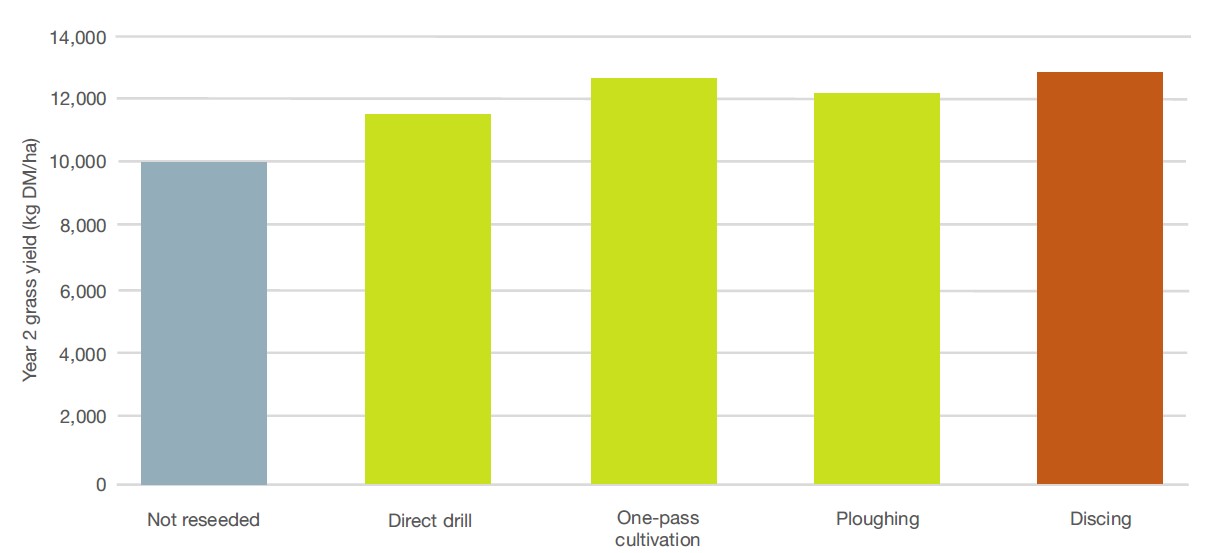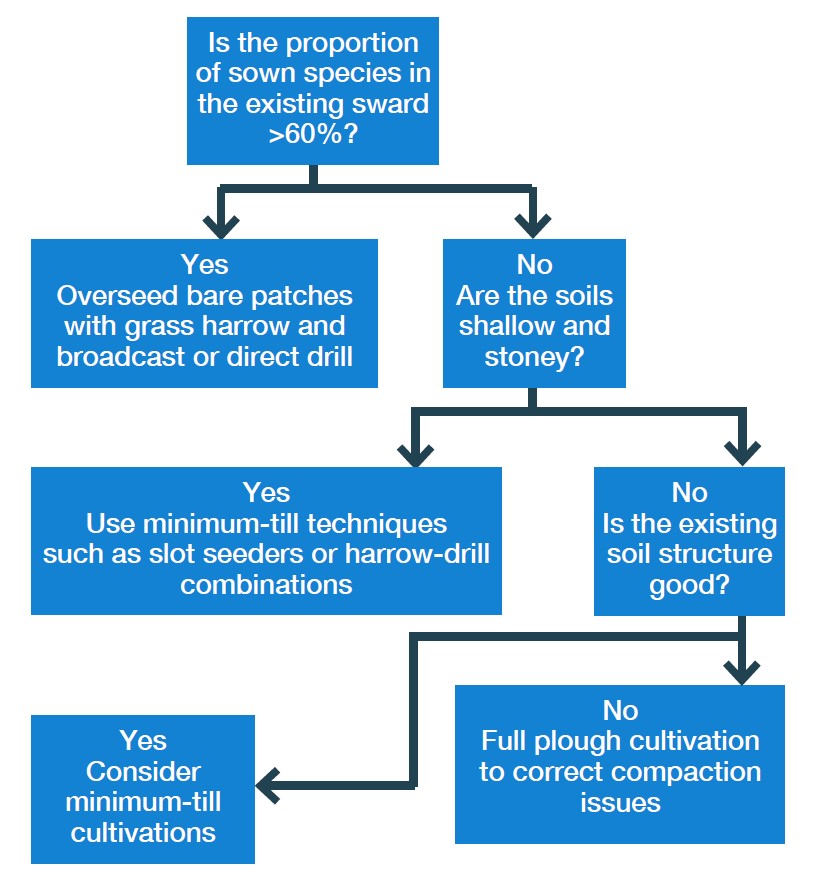- Home
- Knowledge library
- Grassland reseeding: establishment methods
Grassland reseeding: establishment methods
Our decision tree will help you to decide which reseeding method to choose. We’ve also got information on using a pre-cultivation spray and results from our reseeding survey.
Back to: Establishing grassland reseeds
Which establishment method should I choose?
Achieving a level, uniform seedbed is important to ensure a consistent sowing depth. It is vital to select the right technique to suit the farm and soil conditions. Under correct conditions, the impact of reseeding technique on sward productivity is small.
Recent research undertaken in Ireland has shown comparable yield benefits to reseeding with discing, one-pass cultivation and ploughing (see graph below).
Results from Irish work on the impact of cultivation technique on grass yield

Choosing the correct cultivation technique
Cultivation technique can be selected based on various factors, such as soil type and existing sward conditions. The cost of the technique needs to be taken into consideration. Each technique has several advantages and disadvantages.
A decision tree for choosing a cultivation technique

Example costs of different reseeding techniques (£/ha)
|
|
Full cultivation |
Minimum-till cultivation |
Overseeding |
|
Soil analysis |
3 |
3 |
3 |
|
Spray |
30 |
30 |
|
|
Spraying |
27 |
27 |
|
|
Plough |
61 |
|
|
|
Power harrow |
50 |
50 |
|
|
Power harrow |
50 |
|
|
|
Land leveller |
17 |
17 |
|
|
Seed |
161 |
161 |
79 |
|
Sow |
22 |
79 |
79 |
|
Roll |
17 |
17 |
17 |
|
Fertiliser–100 kg 18:14:14 + spreading |
94 |
94 |
94 |
|
Lime-2 t +application |
126 |
126 |
126 |
|
Leatherjacket control |
12 |
12 |
12 |
|
Slug pellets |
20 |
20 |
20 |
|
Total cost (£/ha) |
689 |
636 |
430 |
The pros and cons of cultivation techniques
|
|
Pros |
Cons |
|
Ploughing |
Good seed-soil contact
Can remove compacted layers in topsoil
Achieves level even seedbed
Buries pests and trash
Most reliable method |
Expensive due to the number of cultivations
Deep ploughing removes nutrient-rich soil from surface
Light soils can dry out quickly
Disturbs seed bank of weeds in soil |
|
Minimum cultivation, e.g. discing, one-pass |
Cheaper than full plough
Fertile soil remains at surface
Limited disturbance of soil structure |
Difficult to remove trash
Decaying trash can release organic acids, hindering germination
Takes longer to achieve an even level finish across field |
|
Direct drill into existing sward |
Opportunity to maintain existing sward
No cultivation reduces costs
No disturbance of soil structure |
Hard for cultivars to compete against existing sward
Not suitable for dry, hard ground
Results can be variable |
Pre-cultivation spray
Before reseeding, applying herbicide to the existing sward can remove any existing weeds and reduce competition for the new ley. Trials undertaken in New Zealand achieved a plant count of 400 plants/m2 in the reseed when using a pre-cultivation herbicide. This was reduced to 120 plants/m2 when the herbicide was omitted.
It is important to allow sufficient time between herbicide application and sowing the seed.
- Contact between the seed and chemical may negatively affect germination rates
- Cultivations can usually begin seven to ten days after spraying, but it is important to check the product recommendations
Pesticide legislation
Everyone applying pesticides is required to have a certificate of competence and the sprayer must have passed a test. More information can be found at: voluntaryinitiative.org.uk
Always wear appropriate protective clothing and take care when handling pesticides. More information can be found at: hse.gov.uk/pesticides
Reseeding survey results
A survey looking into current reseeding practices on farm was conducted by AHDB during 2016, with technical assistance from Field Options. Some of the findings from the survey show:
- Before reseeding, 58% of respondents treated the existing sward with glyphosate
- About 46% of respondents ploughed and cultivated, another 19% cultivated but did not plough
- Around 12% surface-seeded, with about 10% using a direct drill
Useful links
Grassland reseeding: top tips for ploughing, cultivation and overseeding

